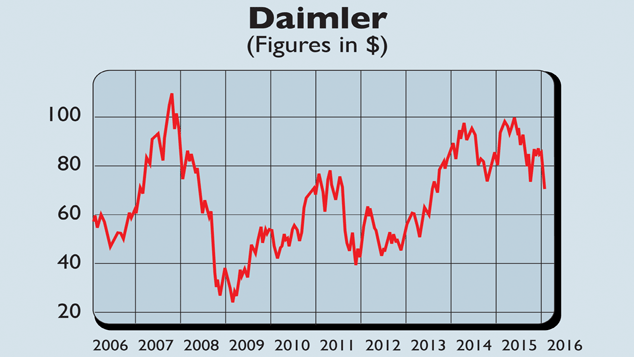Driverless cars: the rout of the petrolheads
Lovers of driving and gas-guzzlers are in for a disappointment – the future is electric and driverless. Matthew Partridge tips the best stocks to profit.


Lovers of driving and gas-guzzlers are in for a disappointment the future is electric and driverless, says Matthew Partridge.
The idea of self-driving cars, long a staple of science fiction, is now tantalisingly close to becoming reality. In recent years progress in the field has accelerated rapidly, fuelled by surging interest from carmakers, consumers, technology firms and governments. Even in the 18 months since we last covered the topic, there have been dramatic changes.
Just a few weeks ago, for example, America's president, Barack Obama, promised to invest $3.9bn in the sector and standardise testing regulations across America, smoothing the development process. A world of mass-produced, autonomous vehicles will be hugely disruptive, not just for the car industry, but also for many other businesses. So where do the biggest opportunities for investors lie?
MoneyWeek
Subscribe to MoneyWeek today and get your first six magazine issues absolutely FREE

Sign up to Money Morning
Don't miss the latest investment and personal finances news, market analysis, plus money-saving tips with our free twice-daily newsletter
Don't miss the latest investment and personal finances news, market analysis, plus money-saving tips with our free twice-daily newsletter
Many of the big car manufacturers and several technology firms are developing self-driving technology, or have plans to do so (see below). However, the firms currently in pole position are Google (Alphabet), Mercedes and Audi. Mercedes' prototype, the F-015, has been on show at technology events and test-drives on both private tracks and public streets. Journalists who have been driven by the car have been very positive: AutoExpress describes being a passenger as "a completely alien but absorbing experience", while Engadget "appreciated how futuristic the technology was".
Google has been running trials on public roads in the US for the past five years, with 1.3 million miles driven in total. At first, Google used modified versions of existing cars, but it is now developing its own prototypes, with rumours of a potential joint venture with Ford. Finally, Audi has also produced some impressive results. One version of its A7 model can navigate busy roads and circuit a racing track faster than the best human drivers. Audi hopes that autonomous, or near-autonomous, cars will appear in showrooms as early as 2019.
But for now, the closest you can get to a self-driving car on the road is Tesla's Model S. A "summon" mode will see the car manoeuvre out of a parking space without human input, while autopilot will completely take over driving for long stretches. Tesla specifically recommends that you only use the system on motorways and the autopilot will automatically disengage if it thinks that driving conditions are too difficult.But as Top Gear reviewer Stephen Dobie notes, "simply by having both wheel and pedal duties taken away from you, a busy motorway becomes a much, much more relaxing place to be".
And even if entirely autonomous cars take longer to appear than we might hope, there are already a number of sophisticated driving aids built in to many high-end cars as standard. You can buy a car that will parallel park itself without human input. There are also systems that will automatically brake in an emergency to avoid collisions tests suggest that these can reduce accidents by a third, and ten major carmakers pledged last year to roll them out quickly.
Cheerio, guv'nor
Fewer accidents and a more pleasant driving experience who wouldn't want that? Well, as with any major technological advance, there will be losers as well as winners. Taxi and minicab firms are already feeling the pain of competition from "gig economy" services such as Uber and Lyft, which allow anyone to set up as a cab driver and make it very convenient to hail one. However, self-driving taxis would do away with the human element altogether. That could cut costs by up to 70%, reckons Robot Taxi (a joint venture between Japanese tech firms DeNA and ZMP), meaning cheaper fares.
Robot Taxi plans to trial the world's first self-driving taxi service from March and aims to expand across Japan in time for the Tokyo Olympics in 2020. Theoretically, there's no reason why the entire process of running a taxi service couldn't eventually be automated. Futurist Mike Hearn envisages a service where robots not only drive the cars, but set prices, manage routes, and order new cars from the manufacturers when needed. The technology already exists (Uber uses algorithms to manage pricing, for example). It is just a matter of putting it all together and fine-tuning its reliability.
Cheap, plentiful taxis could also address one big problem with car ownership waste. On average, owners use their vehicles for just an hour a day. A study last year by the OECD think tank suggested that greater use of taxis would cut congestion and reduce required parking space, freeing up land for other uses. Initially, people are unlikely to give up their cars, but in the longer run, cheap, reliable self-driving cabs, accessible when you need them, are likely to mean fewer cars on the roads a challenge to the business models of car manufacturers.
So it's no surprise that both tech groups and carmakers are now investing in taxi firms. Google and Chinese tech giant Baidu have both invested in Uber, which is partnering with Carnegie Mellon to developself-driving taxis. In an effort to hedgeits bets if people switch from car ownership to taxis, General Motors has pumped $500m into Lyft, which will use the funds to develop self-drivingcar technology.
Public transport and road haulage
Self-driving technology will also transform public transport and road haulage. Growing populations in the world's major cities are increasing congestion and putting a major strain on public transport systems. Transport for London reckons that over the next 35 years tube capacity in the city will have to grow by 60% and rail capacity by 80% to match projected demand. Robot buses could help with this.
By increasing safe driving speeds, reducing safe distances between buses, and cutting labour costs, self-driving buses could increase the number of passengers transported, in turn easing pressure on other parts ofthe network. The gains could be huge. For example, Professor Alain Kornhauser of Princeton University thinks autonomous technology could increase the carrying capacity of the(New York/New Jersey) Lincoln Tunnel's bus lanes fivefold.
Many cities are now investigating this seriously. The Swiss town of Sion is starting a two-year trial of self-driving minibuses this year, while Singapore plans to introduce similar technology in 2016.Baidu hopes to mass-produce its own self-driving buses before the endof the decade.
Vehicle autonomy could revolutionise the transport of goods as well as people. Road haulage is vital to the global economy around half of Europe's freight travels by roads; 1.5% of the Canadian population work as truck drivers. Yet the industry is going through a recruitment crisis existing drivers are retiring and younger people don't want to do what can be a tedious, lonely job. The industry also has a poor safety record compared to other forms of road transport, with HGVs involved in 6,000 road accidents in the UK alone in 2013.
As a result, haulage firms, especially those involved in mining and energy, are also working on self-driving technology. For now, the focus is mainly on moving raw materials around specific sites, with Rio Tinto investing in a fleet of robot trucks to transport iron ore. But some firms are examining public road usage. Canadian oil sands firm Suncor Energy Inc plans to phase out human drivers almost entirely within the next five years, and Mercedes is testing autonomous trucks on Nevada's highways.
What if your car is hacked?
Of course, one problem with computers being in charge rather than humans is that computers can be hacked. Last year, Charlie Miller and Chris Valasek shocked the car industry when they released a video in which they used their own software to bring a Fiat Chrysler jeep travelling on the motorway to a dead halt. Samy Kamkar did a similar thing to one of GM's models, posting a video showing him remotely starting the car's engines.
Both stunts were by "white-hat" hackers aiming to bring security flaws to people's attention so noone was hurt. But it doesn'ttake much imagination to work out how a terrorist or plain mischief-maker could usesimilar techniques to createchaos and carnage.
GM claims to have fixed the flaw that allowed Kamkar to take control, while Chrysler temporarily recalled 1.4 million affected vehicles so that a software patch could be installed. However, this issue isn't likely to be specific to those particular companies or cars. In 2014, Miller and Valasek were commissioned by the US Defense Advanced Research Projects Agency (DARPA) to measure how vulnerable 20 leading car models were to hackers. A few models proved resilient, but several big names were considered highly vulnerable.
As a result, regulators are pressuringthe industry to act. This month, theUS Department of Transportation finalised an agreement with 17 car companies, forcing them to work together to combat potential threats and to be far more proactive about reporting known issues. ENISA, the European Agency tasked with dealing with cybersecurity threats, has also said that it will set up a task force to investigate this issue starting this year.In short, huge changes are coming down the road, faster than you think. Now is a good time to position your portfolio to take advantage. We look at some of the best options below.
The end of petrol?
As well as increasing autonomy, expectmore electric cars on the roads too.Tesla chief executive Elon Musk haswarned that cheap oil may make themless attractive, but several nations,including Germany, plan to boostbuyer subsidies to speed adoption,while the UK government has allocated£40m to councils who can come upwith schemes to encourage peopleto switch to electric.
Given that halfof American oil consumption is usedin cars (according to the EnergyInformation Administration), it'sanother reason to believe that oil pricescould struggle in the very long run.
The world's largest carmakers
| Toyota | 10.2 | Testing driverless cars now, and plans to start selling them by 2020. |
| Volkswagen | 10.1 | Has formed a partnership with Mobileye to develop advanced image processing software for use in future driverless cars. |
| General Motors | 9.92 | Has invested $500m in taxi service Lyft. Plans to release a Cadillac with "super-cruise" technology in 2017. |
| Renault-Nissan Alliance | 8.47 | Plans to have cars with driverless capabilities in showrooms by 2020. |
| Hyundai | 7.71 | Plans to spend nearly $10bn over the next five years on driverless technology and driver assistance features, leading to a fully automated car by 2030. |
The best stocks to buy now
One of the few remaining barriers to mass adoption of driverless cars is the scale of the computer equipment needed to power them. Computer graphics card maker Nvidia (Nasdaq: NVDA) is working on developing special chips that will further reduce the size of the equipment needed. Nvidia should also continue to benefit from the boom in video games sales (growing at 8%-10% each year) and the rise of virtual reality software. The stock looks good value, despite trading at 19 times 2016 earnings.
Mobileye (NYSE: MBLY) makes collision avoidance systems, so it should benefit from a drive to make these standard in cars. It has already agreed a deal with Volkswagen to provide the process software used in driverless cars. On 39 times 2016 earnings, it certainly isn't cheap. But it is one of the purest plays on the rise of robot cars and is the technological leader in this area it recently unveiled a "Road Experience Management" system that allows users to pool data to create extremely accurate road maps.
Delphi Int. (NYSE: DLPH) is a major car parts manufacturer. It has invested heavily in self-driving technology, claiming that its laser-based systems are better at detecting threats than those that use radar. In 2014 a car using its technology travelled from San Francisco to New York with minimal human intervention. It has also played a key role in developing the "super-cruise" feature due to appear on a future GM Cadillac, and claims to have overhauled its system to thwart hackers. It trades at 10.7 times 2016 earnings.
Harman International (NYSE: HAR) specialises in "infotainment" systems, which combine entertainment systems and visual driver aids in one package. It also hopes to take advantage of the predicted surge in demand for car-related cybersecurity, and has purchased two security companies in the last year: Red Bend and TowerSec. All of this is part of an ambitious plan to fight competition from Google and other new entrants into the market, and to double revenue within five years. Harman trades at 12.4 times 2016 earnings.
Even though its share price has fallen since its peak in 2014, Tesla (Nasdaq: TSLA) is still far too expensive at 50 times 2017 earnings. Instead, we'd recommend Daimler (Frankfurt: DAI) as a play on autonomous car manufacturing. Daimler owns Mercedes, which is one of the firms that is closest to putting self-driving cars on the road.

Mercedes also plans to attack Tesla on another flank by producing several electric cars within the next two years. Thanks to the market shunning European carmakers after the Volkswagen scandal, Daimler currently trades at only 7.2 times 2016 earnings. This means that even if there aren't any significant developments in the next few year, it still looks like a solid value play.
One company that has the potential to change the playing field completely is Apple (Nasdaq: AAPL). For the past year there have been growing indications that Apple is planning to develop an "iCar", either on its own, or in conjunction with a major carmaker. The company has been hiring a lot of car designers and engineers, taking out patents, and allegedly even building a large test track.
While one of the major designers involved in "Project Titan" has suddenly left the company, Apple has so much cash that it could simply buy one of the leading technology firms if necessary. Even if it doesn't enter the car sector, it currently trades at 10.3 times 2016 earnings with a current dividend of 2.1%, making it look a reasonable bet, despite the recent slowdown of iPhone sales.
Get the latest financial news, insights and expert analysis from our award-winning MoneyWeek team, to help you understand what really matters when it comes to your finances.

-
 Profit from leisure sector as consumers go on spending spree
Profit from leisure sector as consumers go on spending spreeThe UK leisure sector had a straitened few years but now have cash in the bank and are ready to splurge. The sector is best placed to profit
-
 Nationwide: Annual house price growth slows to lowest level in almost two years
Nationwide: Annual house price growth slows to lowest level in almost two yearsThe average house price went up by just 0.6% between December 2024 and December 2025, Nationwide Building Society said
-
 Governments will sink in a world drowning in debt
Governments will sink in a world drowning in debtCover Story Rising interest rates and soaring inflation will leave many governments with unsustainable debts. Get set for a wave of sovereign defaults, says Jonathan Compton.
-
 Why Australia’s luck is set to run out
Why Australia’s luck is set to run outCover Story A low-quality election campaign in Australia has produced a government with no clear strategy. That’s bad news in an increasingly difficult geopolitical environment, says Philip Pilkington
-
 Why new technology is the future of the construction industry
Why new technology is the future of the construction industryCover Story The construction industry faces many challenges. New technologies from augmented reality and digitisation to exoskeletons and robotics can help solve them. Matthew Partridge reports.
-
 UBI which was once unthinkable is being rolled out around the world. What's going on?
UBI which was once unthinkable is being rolled out around the world. What's going on?Cover Story Universal basic income, the idea that everyone should be paid a liveable income by the state, no strings attached, was once for the birds. Now it seems it’s on the brink of being rolled out, says Stuart Watkins.
-
 Inflation is here to stay: it’s time to protect your portfolio
Inflation is here to stay: it’s time to protect your portfolioCover Story Unlike in 2008, widespread money printing and government spending are pushing up prices. Central banks can’t raise interest rates because the world can’t afford it, says John Stepek. Here’s what happens next
-
 Will Biden’s stimulus package fuel global inflation – and how can you protect your wealth?
Will Biden’s stimulus package fuel global inflation – and how can you protect your wealth?Cover Story Joe Biden’s latest stimulus package threatens to fuel inflation around the globe. What should investors do?
-
 What the race for the White House means for your money
What the race for the White House means for your moneyCover Story American voters are about to decide whether Donald Trump or Joe Biden will take the oath of office on 20 January. Matthew Partridge explains how various election scenarios could affect your portfolio.
-
 What’s worse: monopoly power or government intervention?
What’s worse: monopoly power or government intervention?Cover Story Politicians of all stripes increasingly agree with Karl Marx on one point – that monopolies are an inevitable consequence of free-market capitalism, and must be broken up. Are they right? Stuart Watkins isn’t so sure.